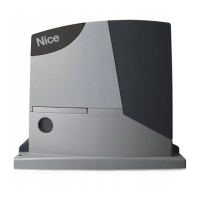EN
9 – English
7.2.6 - Level two programming example (adjustable parameters)
Thesequencetofollowinordertochangethefactorysettingsoftheparametersadjustingthe“MotorForce”ontheaverage(inputonL1andL2levels)increasing
the“PauseTime”to60seconds(inputonL3andlevelonL3),andhavebeenincludedasexamples.
TABLE 18 - Level two programming example
01. Press the button [Set]andholditdown(approx.3s)
02. Release the [Set]buttonwhenL1LEDstartsashing
03. Press the button [Set] and hold it down during step 4 and 5
04. Waitapprox.3secondsuntilLEDL3,representingthecurrentlevelofthe“MotorForce”willlightup
05. Press the [st] button twice to move the LED which is lit to LED L2, which represents the new “Motor Force” value
06. Release the button [Set]
07. Press the [st]buttontwicetomovetheashingLEDtoLEDL3
08. Press the button [Set] and hold it down during step 9 and 10
09. Waitapprox.3secondsuntilLEDL2,representingthecurrentlevelofthe“PauseTime”willlightup
10. Press the [st] button once to move the LED which is lit to LED L3, which represents the new“Pause Time” value
11. Release the button [Set]
12. Wait10secondsbeforeleavingtheprogrammetoallowthemaximumtimetolapse
3 s
10 s
L1
3 s
L3
L2
3 s
L3
L3
SET
SET
SET
SET
SET
SET
7.3 - Adding or removing devices
Devices can be added to or removed from the Road400 automation system at
any time. In particular, various devices types can be connected to “STOP” input
as explained in paragraphs “7.3.1 STOP Input”.
7.3.1 - STOP input
STOP is the input that causes the immediate interruption of the manoeuvre
(withashortreverserun).Deviceswithoutputfeaturingnormallyopen“NO”
contacts and devices with normally closed “NC” contacts, as well as devices
with8,2KΩconstantresistanceoutput,likesensitiveedges,canbeconnected
to this input.
During the recognition stage the control unit recognizes the type of device con-
nectedtotheSTOPinput(seeparagraph4.3“RecognitionLengthoftheLeaf”);
subsequently it commands a STOP whenever a change occurs in the recog-
nized status.
Multiple devices, even of different type, can be connected to the STOP input if
suitable arrangements are made.
• Any number of NO devices can be connected to each other in parallel.
• Any number of NC devices can be connected to each other in series.
•Severaldeviceswith8.2KΩconstantresistanceoutputcanbeconnected“in
cascade”withasingle8.2KΩterminationresistance.
• It is possible to combine Normally Open and Normally Closed by making 2
contactsinparallelwiththewarningtoplacean8.2KΩresistanceinseries
withtheNormallyClosedcontact(thisalsomakesitpossibletocombine3
devices:NormallyOpen,NormallyClosedand8.2KΩ).
If the STOP input is used to connect devices with safety functions,
only the devices with 8,2KΩ constant resistance output guarantee the
fail-safe category 3 according to EN standard 954-1.
7.3.2 - Photocells
The Road400 control unit is equipped with the “Phototest” function which
increases the reliability of the safety devices, making it possible to achieve “cat-
egory2”incompliancewithUNIEN954-1(edition12/1998),inrelationtothe
combination of control unit and safety photocells.
Every time a manoeuvre is activated the related safety device is controlled and
only if everything is correct is the manoeuvre started.
Whereas,ifthetesthasanegativeoutcome(photocellblindedbythesun,short
circuitedcableetc),thefaultisidentiedandthemanoeuvreisnotperformed.
To add a pair of photocells, make the following connections.
• Connection without “Phototest” function (g. 21 - 22):
Powerthereceiverdirectlyfromthecontrolunitservicesoutput(terminals1-4).
• Connection with “Phototest” function (g. 23 - 24):
The photocell transmitter power supply is not taken directly from the services
but through terminals 6-4 of the “Phototest” output. The maximum usable
current on the “Phototest” output is 100 mA.
Activate the synchronism as described in the photocell instructions if 2 pairs of
photocells are used that could interfere with one another.
7.4 - Special functions
7.4.1 - “Always open” Function
The “Always open” function is a control unit feature which enables the user to
control an opening manoeuvre when the “Step-by-Step” command lasts longer
than 3 seconds. This is useful for connecting a timer contact to the “Step-by-
Step” terminal in order to keep the gate open for a certain length of time, for
example. This feature is valid with any kind of “Step-by-Step” input program-
ming. Please refer to the “Step-by-Step Function” parameter in Table 15.
7.4.2 - “Move anyway” function
In the event that one of the safety devices is not functioning properly or is out of
use, it is still possible to command and move the gate in “Man present” mode.
Please refer to the Paragraph “Control with safety devices out of order” in the
enclosure“InstructionsandWarningsforusersoftheROADgearmotor”for
further information.
7.5 - Connection of other devices
If the user needs to feed external devices such as a proximity reader for tran-
sponder cards or the illumination light of the key-operated selector switch, it
is possible to tap power as shown in Figure 25. The power supply voltage is
24Vcc-30%-+50%withamaximumavailablecurrentof100mA.

